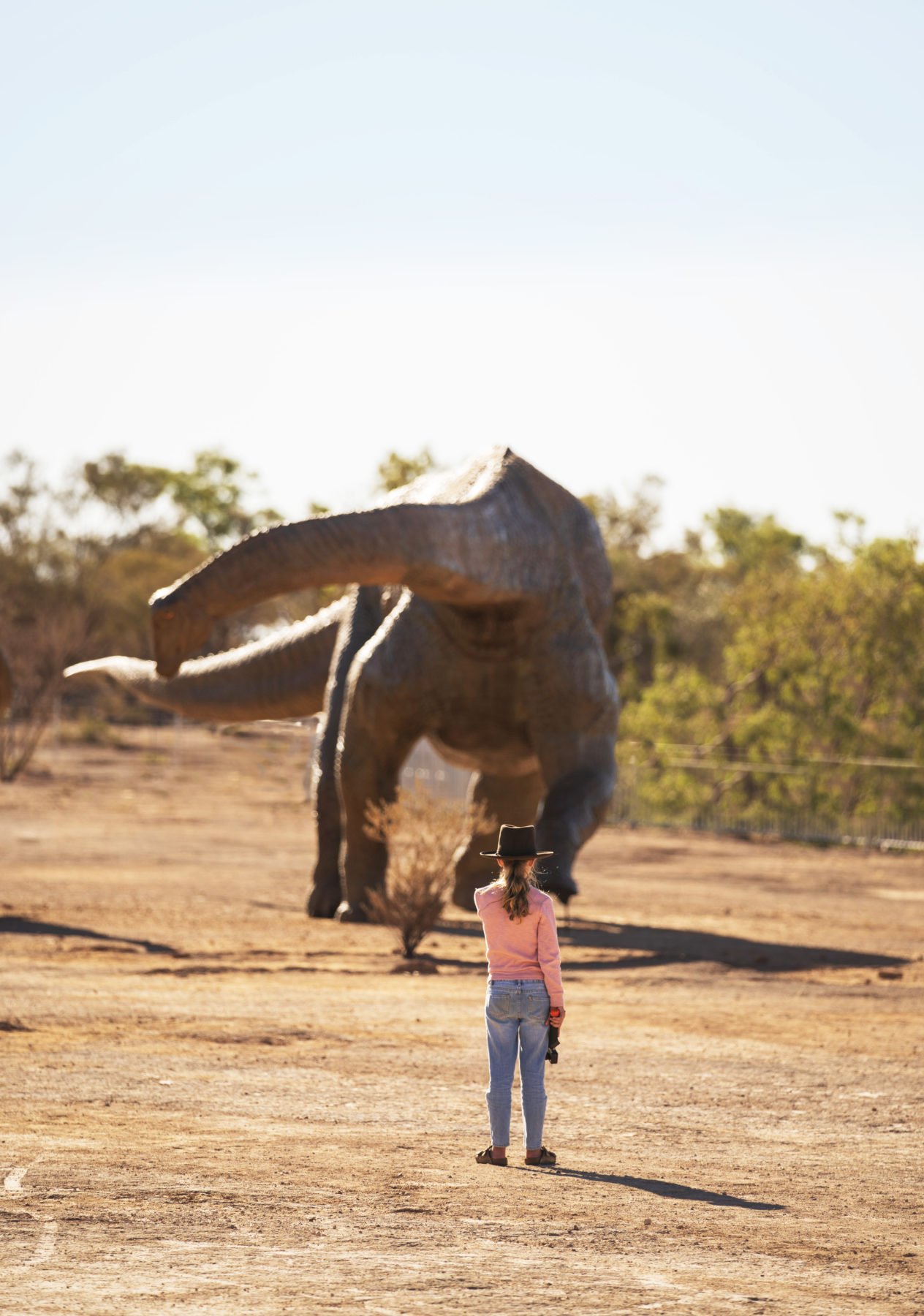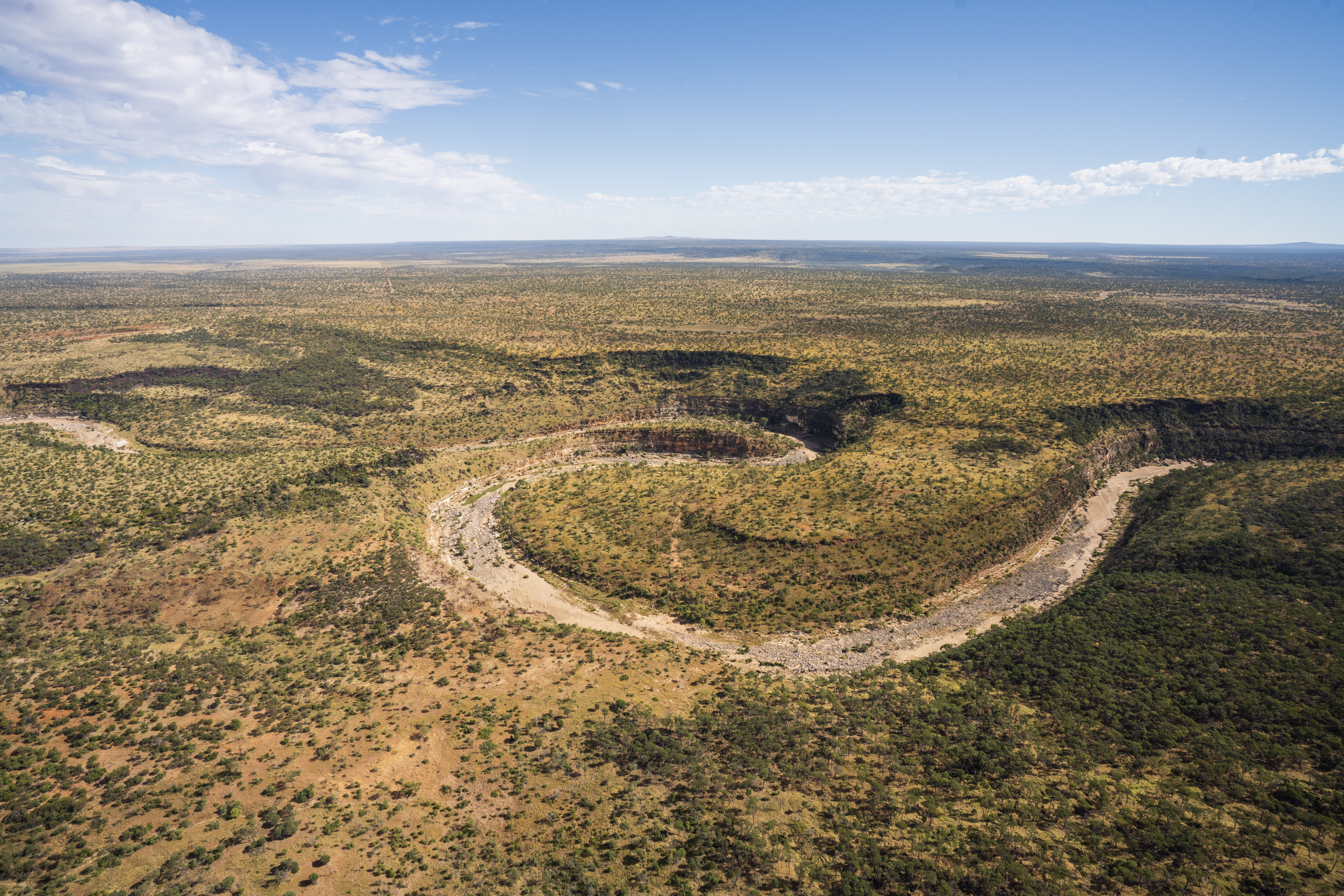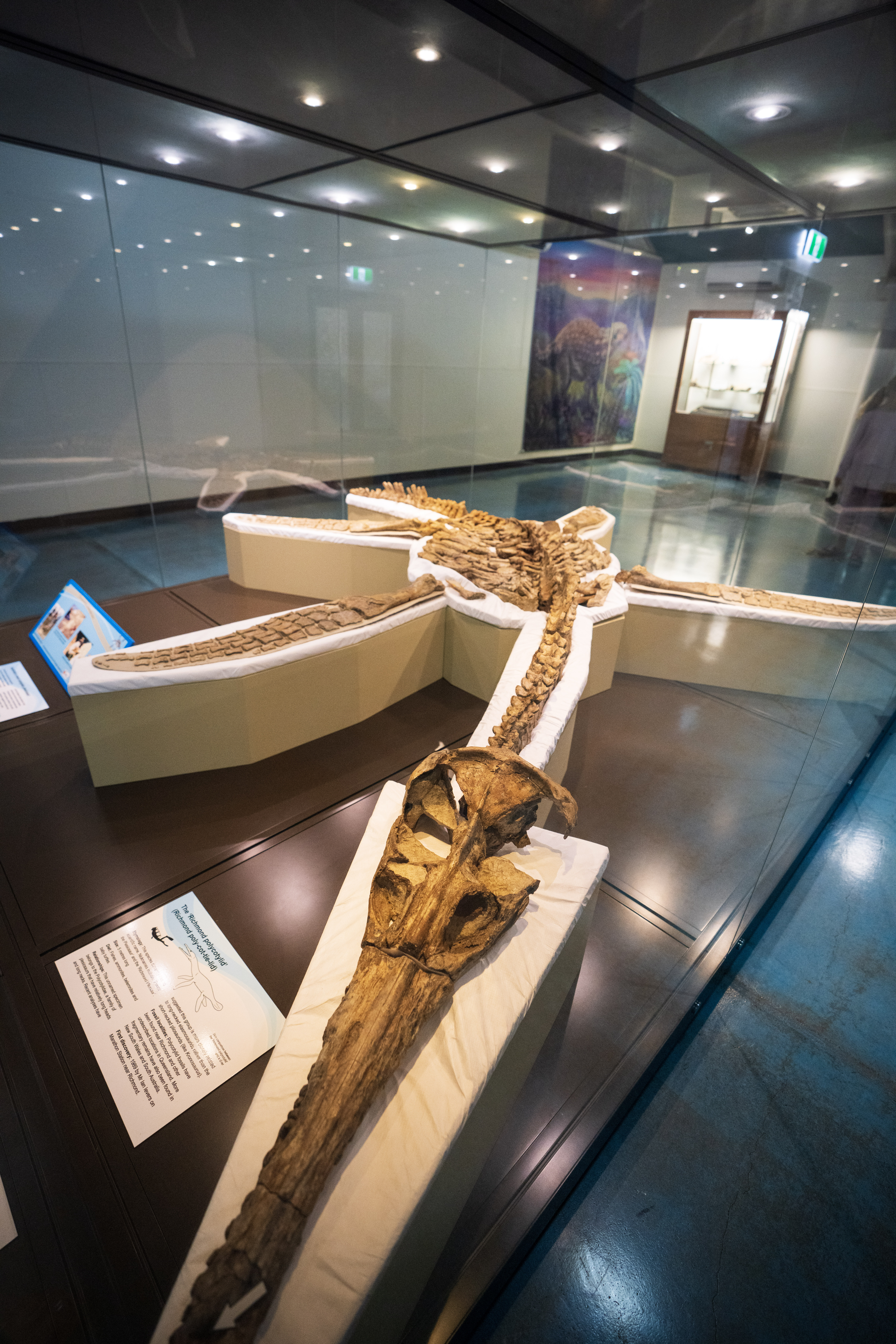A guide to exploring Outback Queensland’s dinosaur trail

TOURING OUTBACK QUEENSLAND with my family to learn about Australia’s prehistoric past is an exciting prospect. The allure of vast, red, spinifex-studded landscapes, along with the appeal of seeing dinosaur footprints, fossicking for fossils, and visiting world-class museums, piques my curiosity.
But with my nine-year-old daughter, Tiah, in tow, a multiday history lesson seems ambitious. That is, until I mention we’ll be digging for dinosaurs. Instantly, Tiah’s eyes light up and without hesitation she’s in.
We’re embarking on a six-day, 900km drive along the Overlanders Way – officially the Flinders (A6) and Barkly (A2) highways – from Townsville, on Queensland’s north-east coast, west to Mount Isa. During our road trip, we’ll see some of the world’s best-preserved dinosaur fossils and visit parts of Australia’s premier dinosaur graveyard – the outback triangle that links the historic towns of Hughenden, Richmond and Winton.
Our journey begins at Townsville’s Museum of Tropical Queensland. Here, the Ancient Seas and Reefs exhibit details the state’s geological history, demonstrating changes that occurred during millions of years, when inland seas and ancient reefs covered the landscape and gigantic marine reptiles inhabited the Earth.
The Cretaceous Period, 145–66 million years ago (mya), was an extraordinary time for Queensland’s outback. Earlier geological activity caused a vacuum-like inversion that sank the continent’s centre, and the shallow Eromanga Sea formed across much of inland Australia. It covered the landscape 120–90mya, providing an oasis for wondrous creatures. Australia’s most beautiful and complete fossils from this time are of the spectacular marine reptiles that called this sea home.
Museum volunteer coordinator Tye Jeffrey tells us about ichthyosaurs, plesiosaurs, pliosaurs and mosasaurs – all monstrous marine creatures that spark wonder in Tiah’s imagination. Tye is a Queensland local with strong family connections to the country we’re about to visit. He and his family owned a cattle property and he regales us with tales of the land and tells us about some of the impressive fossils that have been discovered in outback Queensland.
My budding palaeontologist daughter is enthralled by the prospect of finding bits of enormous marine reptiles, some that grew up to 20m long, weighed more than a tonne and had sharp teeth up to 30cm long. “But if dinosaurs lived on land, how will we find bones if the land was actually a sea?” Tiah asks, both of us surprised that marine reptile fossils are not technically classed as dinosaurs.
It’s a valid question and draws a blank from me, but Tye assures us dinosaur fossils are certainly found in areas covered by inland seas. “Dinosaurs could have washed in, or, because they were so heavy, become stuck in muddy parts of the sea before perishing,” he says. “They’re definitely out there.”
Having absorbed more information about Queensland’s prehistoric past in a day than we previously had in our lifetimes, I’m confident this road trip will be filled with discovery. We excitedly set off in our campervan towards Hughenden, giddy with anticipation.

Porcupine Gorge, Australia’s “little Grand Canyon”
Hughenden, located about 390km south-west of Townsville, is on what was once the shoreline of the Eromanga Sea. Impressive fossil finds have been recorded here.
At the town’s Flinders Discovery Centre, tourism adviser Jennifer Tasker attributes the fossil finds in part to the fact that the sea’s edge would have been a hive of activity. It would have been home to terrestrial dinosaurs, including Muttaburrasaurus, a genus of herbivorous dinosaurs up to 9m long, as well as many marine reptiles, including giant turtles and primitive birds and pterosaurs.
About 65km north of Hughenden lies the awe-inspiring ancient landscape of Porcupine Gorge, often referred to as Australia’s “little Grand Canyon”. Towering sandstone cliffs rise here from the surrounding savannah plains and pockets of vine forest are clustered along Porcupine Creek, which features deep permanent waterholes.
The area is home to an iconic rock formation known as the Pyramid, a sandstone monolith shaped as its name suggests that rises from the gorge floor.
My family and I stay overnight at the Pyramid camping ground in Porcupine Gorge National Park. To better appreciate the vastness of the landscape, we decide to take to the skies for an aerial view of the gorge and organise for a helicopter to pick us up from the campsite in the morning. As we head to the chopper we joke about being rock stars, but the real rock star here is the Jurassic sandstone, exposed in the towering 120m-high walls of the gorge.
Hundreds of millions of years of erosive forces have coloured and sculpted the sandstone and caused a deep chasm where Porcupine Creek now lies, its pools glistening like a string of glass beads. During the wet season, the waterway cascades through the gorge.
From the air, we can see evidence of the region’s geological timeline in the landscape. Huge river systems flowed across the continent, dumping enormous deposits of sediment and shaping the land. These massive sand and silt deltas preserve remnants of the region’s prehistoric past.
Our aerial tour continues over White Mountains National Park, where we see more astounding dome-shaped rock formations, spectacular white sandstone bluffs, and lush forests that sprout from creases and folds in the terrain. Landing to picnic on the banks of the Flinders River, Queensland’s longest river, is a highlight. From the ground, we truly appreciate how complex the landscape is and can’t help but imagine it filled with the prehistoric creatures that once called it home.
On our return to the Flinders Discovery Centre we’re stopped, literally, in our tracks by a life-sized skeletal replica of Muttaburrasaurus langdoni. ‘Hughie’, as he’s known, is the hero of the centre’s exhibits. Seeing the 7m-long dinosaur gives us a real understanding of just how impressive the creatures that roamed this landscape must have been.
The first Muttaburrasaurus fossils (parts of a partial skeleton) were discovered in 1963 by grazier Doug Langdon near the Central Queensland town of Muttaburra. More fossilised Muttaburrasaurus remains were later discovered on Dunluce and Iona stations, both near Hughenden. A possible second species was later found at Lightning Ridge, in New South Wales. Species in the genus Muttaburrasaurus were the most widely distributed of the Australian dinosaurs. As herbivores, they likely grazed on the rich Araucaria conifer forests and ferns fringing the Eromanga Sea.
Eager to now get our own fossicking underway, and with a map from the Flinders Discovery Centre in our hands, we’re guided back to the sandy banks of the Flinders River. After a few hundred metres of scouring, we find some bullet-shaped belemnites (prehistoric squid-like animals) to pop in our bucket. We later learn belemnites were cephalopod molluscs, and although not rare, they are definitely fossils. But what thrills my daughter more is, we’re told, they were often found in the stomach contents of predators, including the fierce ichthyosaurs and plesiosaurs we’d met in Townsville. She’s delighted to have found fossilised dinosaur food.

Richmond, the heart of the inland sea
The next day, during the 115km stretch of road between Hughenden and Richmond, I can easily imagine the landscape being covered by sea. With its kilometres of mostly flat plains sprinkled with more cattle than trees and vast sweeps of golden grasses, these grazing lands resemble a now carpeted ocean floor. Upon reaching Richmond, we learn the town lies at what would have been the heart of the inland sea. It’s also where some of Australia’s most intact fossil creatures have been found.
The first, ‘Penny the Plesiosaur’, is a polycotylid (a type of plesiosaur with an elongated skull, broad body, paddle-like limbs and short tail). It was discovered in 1989 in a creek bed at Marathon Station, near Richmond, by grazier Ian Ievers and remains the most complete fossilised non-avian vertebrate creature found in Australia. Another astonishing find followed on the station soon after. An ankylosaur, later named Kunbarrasaurus ieversi, was discovered the same year. Ankylosaurs are armoured plant-eating dinosaurs and this one was was named by Ian after an Aboriginal shield – kunbarra means shield in the local Wunumara language – in reference to its heavy armour. It remains one of the world’s most complete examples of an ankylosaur.
Other fossils were uncovered on neighbouring properties too, including Australia’s largest fossilised fish, called ‘Wandah’, and a new species of sauropod (a large, long-necked, plant-eating dinosaur), nicknamed ‘Marlin’s Beastie’. The rich fossil finds in the area prompted the Ievers family to champion their vision for Kronosaurus Korner, which has become Australia’s premier marine fossil centre. With support from the local community and council, as well as government funding, the museum opened in 1995. It was originally called the Richmond Marine Fossil Museum, before being later renamed.
On our arrival at the museum, we’re confronted by a huge 11m-long Kronosaurus queenslandicus guarding the entrance. It’s not until we watch an animated film in the museum’s theatre that we understand just how menacing this predatory pliosaur was. The huge marine carnivore lived in the cool waters of the Eromanga Sea, hunting large fish, giant squid, and possibly even large reptiles. As the largest fossil found in Queensland, it’s fitting the centre is named in its honour.
We follow a self-guided audio tour through the exhibits, which feature more than 1200 registered fossils. We’re captivated by stories of how these creatures lived and how their fossils were discovered. Tiah is particularly enthralled to learn about an ichthyosaur fossil nicknamed ‘Wilson’ that was found by seven-year-old Amber Wilson in 2014 at one of the fossil-hunting sites nearby. Amber found a puck-sized vertebrae protruding from a pile of rocks, which turned out to be from a 400kg dolphin-like Platypterygius australis, which lived some 100mya.
Michelle Johnston, Kronosaurus Korner’s curator and interpretation manager, recalls the find as momentous. “Wilson is the most complete ichthyosaur skull in our collection and one of the best found in Australia,” she says. “It’s proof that anyone, even with little to no experience, can find fossils that any palaeontologist would dream about discovering.”
Buoyed by this discovery, we collect our fossil-finding permit and head to one of the two fossil hunting sites located a 20-minute drive away. After a few fun hours of digging, and with a small clutch of interesting bony-looking bits in our collection, we return to Kronosaurus Korner where a palaeontologist looks over our finds.
Tiah’s first piece is identified as a fossil of an Aucellina hughendenensis, a type of clam common to the region. She’s also found a few more belemnites, so is thrilled. My find is a bit more intriguing, or so I think. It’s a rounded knuckle-like bone that I’m convinced is something remarkable. It turns out to be from a kangaroo. “One hundred million years too late, Mum,” my now fossil expert daughter quips.

The Winton Formation
Because it was once covered by water, Richmond is an ideal place to find fossils of creatures that were preserved in the thick sludgy base of the prehistoric sea, especially during its final inundation some 105mya. However, Winton, a three-hour drive south, is home to Australia’s most important area for collecting fossils: the Winton Formation.
Magnificent examples include the most complete fossilised remains of a theropod (a carnivorous dinosaur that walked on two legs) found in Australia, belonging to the species Australovenator wintonensis, and the most complete sauropod (large, long-necked, herbivorous dinosaur) ever found here, a representative of the species Diamantinasaurus matildae. Two sets of multiple dinosaur footprints have been recovered across two different sites, and other fossilised freshwater creatures from the Cretaceous, including lungfish, turtles and crocodiles, have also been discovered. Exceptionally preserved examples of insect and flora imprint fossils found here provide evidence of the time flowering plants first emerged in Australia.
My family and I don’t visit Winton on this journey, but it would be easy to add it as a side trip, particularly if you follow the Australian Dinosaur Trail, a tourist driving route that links Hughenden, Richmond and Winton. Instead, we continue along the Overlanders Way to Julia Creek, about 150km west of Richmond. There we soak in the sublime artesian baths at the Julia Creek Caravan Park.
The water is rich in reportedly naturally healing minerals, including sulfur, calcium and magnesium, and its warmth soothes our shoulders, sore after an afternoon of digging for dinosaurs. The soak does wonders for our souls too. We enjoy the last bath session of the day, which means we can, at the same time, watch the setting sun sink into the riparian grasslands of the Mitchell Grass Downs. After the sun disappears, we enjoy the big outback sky’s spectacular colour changes as dusk sets in and the first stars appear overhead.
The Mitchell Grass Downs, a vast, mostly treeless expanse, is home to the adorable Julia Creek dunnart, a tiny carnivorous marsupial threatened by feral cats. We delight in joining a dunnart feeding session at the Julia Creek Visitor Information Centre’s Beneath the Creek facility. Here, interactive displays and daily feeding sessions help raise awareness for the plight of this struggling nocturnal marsupial.
From Julia Creek, we continue along the Overlanders Way to Cloncurry, where we visit the Cloncurry Unearthed Visitor Information Centre and Museum. The stop provides a fascinating diversion from dinosaurs, offering us a chance to peer into the region’s rich geological past while poring over Australia’s most comprehensive collection of gems and minerals.
A further 45 minutes down the highway, Clem Walton Park is located on the Corella River, at the Corella Dam, which was constructed to service the water needs of nearby Mary Kathleen Mine. It’s a stunning place to stop for the night. Idyllic free camping spots are splayed along the peninsula, overlooking the beautiful waterway where fishing and boating are encouraged.
From Clem Walton Park, the flaming red beauty of the Selwyn Range is in magnificent view. Just beyond the range is the mining town of Mount Isa, where a collection of Sybella granite formations comprise some of the oldest exposed rocks in Queensland, dated at 1.9 billion years old.

A last minute trip to the Riversleigh World Heritage Area
Bringing our attention back to fossils, albeit the more modern kind, one of the world’s richest known deposits of vertebrate fossils is found at the Riversleigh World Heritage Area, located about 300km north-west of Mount Isa.
Recognised by UNESCO as one of the most significant Australian mammal fossil sites, Riversleigh features fossils from cave, lake and stream deposits that together tell the evolutionary story of Australia’s unique wildlife.
My family and I join a discovery tour at the Riversleigh Fossil Discovery Centre in Mount Isa, which is recommended for visitors who plan to make the drive out to Riversleigh.
Our guide, fossil enthusiast Alan Rackham, is a fount of knowledge, who explains the Riversleigh fossil record dates to between 50 and 30mya. It was at this time, after the vast inland seas receded, that the ancestors of many of Australia’s native animals first evolved. The climate was warm and humid, and the landscape covered in thick forest.
The centre is filled with engaging, interactive learning spaces and offers exceptional hands-on experiences. At one station, we dance with a virtual Dromornithid, a giant flightless bird known as a demon duck that stood about 2m tall and weighed some 250kg. These birds lived at Riversleigh about 25mya.
In the centre’s fossil lab, we look through microscopes at tiny teeth and bones that were fossilised in ghost bat guano, and we peer into huge vats to see acid slowly eating away at millions of years of sediment to reveal fossil treasures within.
Alan says prehistoric crocodiles could run as fast on land as modern humans, and that carnivorous kangaroos with sharp teeth dominated the landscape. His enthusiasm for Riversleigh’s fossils and the creatures they represent is infectious. “We started with one dig site and now have almost 300,” he says. “And there’s still approximately 35km of sites we have not yet excavated, so there is plenty left to discover.”
Riversleigh is one of the world’s most important paleontological sites. In 2019, 25 years after it was declared a World Heritage area, Sir David Attenborough prepared a statement for the occasion. “Riversleigh is one of the great wonders of the paleontological world,” he wrote. “What other site has produced such an extraordinary assemblage of mammals, birds, reptiles, and many other creatures completely new to science. Not just one or two species but literally hundreds of them. And not just new but undreamed of.”
I didn’t expect to find such a treasure at the end of our road trip. But it was one of many delights we relished as we banked knowledge and experiences we never imagined possible during a six-day family holiday to western Queensland. To top it all off, we’re taking home the 100-million-year-old fossils we found with our own hands.
Save 10% off the daily hire rate on your next Britz campervan adventure with the exclusive code AUSGEOWITHBRITZ. Code valid for Queensland travel 6 November – 18 December 2021 or 24 January – 9 April 2022. See Britz.com for all the details and to book – offer ends 31 January 2022 and some exclusions apply.




